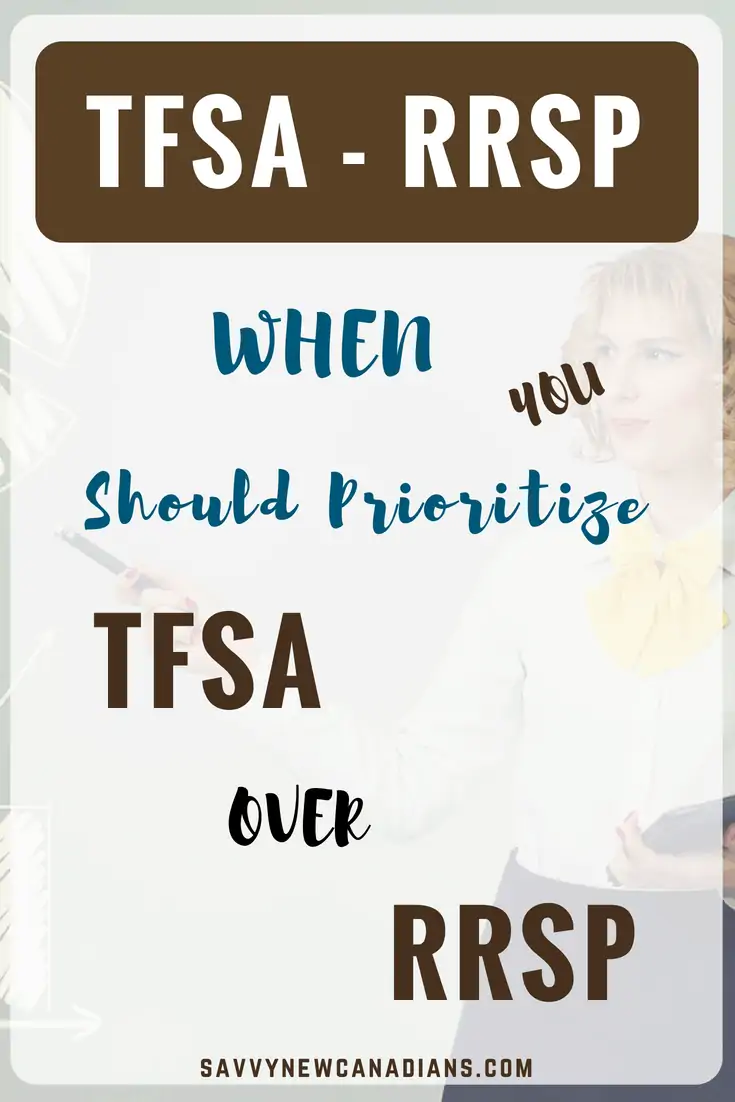We are lucky as Canadians to have access to various tax-sheltered accounts (including RRSP and TFSA) that we can use to grow our retirement savings.
Deciding between a TFSA and vs. RRSP can be a tricky decision to make. Both accounts work well for the purposes they were intended for, but based on your specific circumstances, it may be in your best interest to choose one account over the other.
Before digging into when you should choose a TFSA account over an RRSP, let us quickly summarize what they both offer:
TFSA Overview
The Tax-Free Savings Account, popularly known as TFSA, is a savings tool introduced by the government in 2009.
It allows Canadians who are 18 years of age or older to save or invest a certain amount per year based on contribution limits that are announced annually.
For 2024, the annual contribution amount is $7,000.
If you cannot use up your contribution room for the year, you can carry it forward to future years indefinitely.
If you have been eligible to contribute to a TFSA since its inception and have never contributed, your contribution room is now $95,000.
The investments you can hold in your TFSA account are plentiful, including stocks, bonds, ETFs, mutual funds, index funds, GICs, cash, and more.
Earnings (or interest) realized on your TFSA investments/savings are sheltered from taxes for life. However, unlike the RRSP, your initial contributions to the account are not tax-deductible.
Related: 5 Ways To Invest Your TFSA
RRSP Overview
The Registered Retirement Savings Plan is an account introduced in 1957 that allows Canadians to save towards retirement using tax-deductible contributions.
Each year, the government stipulates the maximum portion of “income” you can contribute to your RRSP account.
For 2024, it is 18% of your earned income, up to a maximum of $31,560.
Like the TFSA, unused contribution room can also be carried forward to future years; however, you can no longer contribute to an RRSP after age 71.
Earnings on your RRSP investments are sheltered from taxes until you withdraw funds.
Unlike the TFSA, your contributions to an RRSP account are tax-deductible, meaning that you do not have to pay taxes on the portion of the income you contribute to the account.
Related: How to Generate Income From Your RRSP in Retirement
TFSA vs. RRSP (With Examples)
Returning to our original question, “Which account should you choose between the RRSP and TFSA?”
In an ideal world, you should choose both accounts and max out your contributions. However, that is not always feasible because you may not have adequate funds to max out both accounts.
So, if you have to choose between contributing to the TFSA or the RRSP, here are some things to consider:
1. Your Tax Bracket Now and In Retirement
In general, if your tax bracket (or marginal tax rate) now is likely going to be higher than your tax bracket in retirement, an RRSP account is preferable to a TFSA.
The reasoning is that your tax savings now (through tax-deductible contributions) will be more than the taxes you pay in retirement when you start withdrawing funds from your RRSP.
For example, assuming you earn $120,000 in Manitoba (marginal tax rate of 43.40%) and contribute $10,000 annually.
If you retire in 30 years with an income of $60,000 and a marginal tax rate of 33.25%, what’s your first $10,000 contribution going to look like under both accounts?
In this scenario, you are better off maximizing your RRSP before your TFSA:
| TFSA | RRSP | |
| Income Contribution | $10,000 | $10,000 |
| Taxes @ 43.40% | $4,340 | 0 |
| After-tax Contribution | $5,660 | $10,000 |
| Annual Investment Return | 7% | 7% |
| # of Years | 30 | 30 |
| Value of Investment in 30 years | $43,086 | $76,123 |
| Taxes @ 33.25% | $0 | $25,311 |
| Net Income after Tax | $43,086 | $50,812 |
On the other hand, if your current marginal tax rate is lower than what it will be when you are retired, it generally makes sense to prioritize your TFSA account over your RRSP.
This is because your tax savings now will be less than the taxes you are required to pay when you withdraw funds from your RRSP in retirement.
For example, let us assume a reverse of the example above, i.e. that your current marginal tax rate is 33.25% and your tax rate in retirement is 43.40%. For the same contribution of $10,000 in an RRSP vs. TFSA, you have:
| TFSA | RRSP | |
| Income Contribution | $10,000 | $10,000 |
| Taxes @ 33.25% | $3,325 | 0 |
| After-tax Contribution | $6,675 | $10,000 |
| Annual Investment Return | 7% | 7% |
| # of Years | 30 | 30 |
| Value of Investment in 30 years | $50,812 | $76,123 |
| Taxes @ 43.40% | $0 | $33,037 |
| Net Income after Tax | $50,812 | $43,086 |
2. If You Have an Entry-Level Job
When you are just entering the workforce and earning a starting (small) salary, you should prioritize your TFSA. A small salary means a lower marginal tax rate and lower tax savings on your contributions.
For example, if you earn $50,000 in Manitoba, your marginal tax rate is 27.75%. This means that a contribution amount of $5,000 to your RRSP will save you $1,387.50.
Compare that to a higher-income earner who makes $105,000 and has a marginal tax rate of 37.90%. For the same RRSP contribution amount of $5,000, they generate tax savings of $1,895 (37% more).
Contributing to a TFSA does not affect your RRSP contribution room…it will continue to grow and can be used up when your income and marginal tax rate increase, and you can get more in tax deductions.
3. Based on Your Income in Retirement
When you withdraw funds from your RRSP in retirement, it counts towards your overall taxable income and can impact other income-tested benefits you qualify for.
For example, if your total retirement income in 2024 exceeds $81,761 (a combination of pensions, RRSP, CPP, OAS…and excluding TFSA), the government will claw back some of your OAS benefits (at the rate of 15 cents for every $1 over the threshold amount).
However, if your total income excluding TFSA is $60,000 and you withdraw $21,761 from your TFSA (for an overall income of $81,761, for example), you will not suffer OAS clawback since the TFSA amount is not considered taxable income.
Essentially, depending on how high your retirement income will be, generating income from a TFSA account can help you keep most or all of your government benefits.
If you expect to qualify for Guaranteed Income Supplement (GIS) benefits, a TFSA is a better option since RRSP income can put you over the income threshold required to qualify for GIS.
4. When Saving for Retirement – Maybe?
RRSP accounts are designed for retirement savings, period. Not for emergency funds or to serve as your piggy bank.
If you decide to start withdrawing funds early for other purposes, you will have to pay taxes immediately (via withholding taxes) and will lose that contribution room permanently.
Some exceptions to this rule are withdrawals under the Home Buyers’ and Lifelong Learning plans.
If you want a savings account you can access with some flexibility, such as for a home downpayment, wedding, vacation, etc., a TFSA is preferable.
Withdrawals can be re-contributed the following year, and your contribution room is not lost. In addition, funds withdrawn are not included in your income, and no tax is due.
5. When Saving for Retirement with no Income
Your total RRSP contribution room is based on your earned income from prior years. Earned income refers to income from employment, rental properties, business income, research grants, royalties, etc.
If you do not have “earned” income and want to grow your retirement pot using a tax-sheltered account, a TFSA is your only choice. You can put cash gifts, cash inheritance, and more in your TFSA.
6. If Saving While Retired
At age 71, you can no longer contribute to an RRSP. However, there is no age limit for a TFSA account. You can save any excess funds you have in a TFSA and have it grow tax-free.
7. If You Have a Group RRSP
If you are enrolled in a Group RRSP at work, and your employer offers contribution matching, it makes sense to take advantage of this ‘free’ money offer and prioritize your group RRSP contributions over the TFSA.
Check out this article for more on Group RRSPs.
Conclusion
Both the RRSP and TFSA are great accounts, and you should utilize them both whenever possible. If you max out your contributions to one account and still have funds to invest, put them into the other account.
You will be thankful you did when retirement comes knocking!
Related Posts:
- Canadian Retirement Income Guide
- The Complete Guide to Robo-Advisors in Canada
- How Much Income Will You Need in Retirement?
- Index Investing For the Newbie Investor
- How To Generate RRSP Income
- RRSP and TFSA Transfers





Good comparison. We have 401 and IRA. Traditional IRA and 401 stack up evenly. I might consider maxing out Roth IRA before maxing out 401 (of course would get the match first).
@Dividend Geek: I am not very conversant with the registered accounts in the U.S., but do know that the 401(k) is very similar to our RRSP. I assume Traditional IRA is more like a TFSA account?
Hi, I was on the Internet and stumbled upon an article about TFSA on Wealthsimple. You were quoted in that article and I was happy to see your name out there. Thanks for the information you put out weekly, it’s changed the way I manage my finances now. Looking forward to this week’s newsletter.
@Eni: Your feedback means a lot, thanks. Glad to hear you find the blog and newsletter useful!